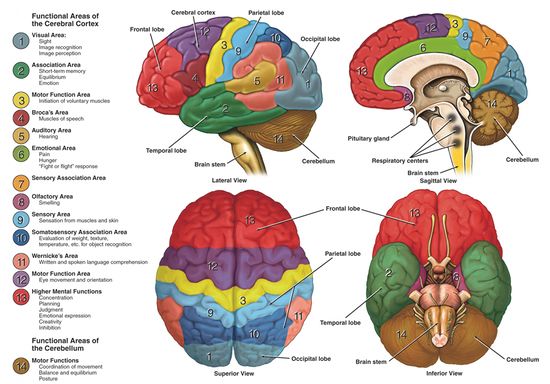The cerebral cortex is a sheet of neural tissue that is outermost to the cerebrum of the mammalian brain. It has up to six layers of nerve cells. It is covered by the meninges and often referred to as gray matter. The cortex is gray because nerves in this area lack the insulation (myelin) that makes most other parts of the brain appear to be white.
 |
| Cerebral Cortex (Neuroanatomy) |
The cerebral cortex
- Represents in humans a highly developed structure concerned with the most familiar functions we associate with the human brain. Between 14 billion and 16 billion neurons are found in the cerebral cortex.
- Highly convoluted external surface of the brain. Its distinctive shape arose during evolution as the volume of the cortex increased more rapidly than the cranial volume resulting in the convolution of the surface and the folding of the total structure of the cortex. If the cerebral cortex were to be removed and unfolded, it would cover several yards or meters.
- The convolutions consist of grooves known as sulci that separate the more elevated regions called gyri.
- The cortex has been divided into four lobes using certain consistently present sulci as landmarks. These lobes are named after the overlying cranial bones: frontal, parietal, temporal and occipital
The main difference between cerebrum and cerebral cortex
- The cerebrum is the largest part of the brain whereas cerebral cortex is the outer layer of the cerebrum.
- The cerebral cortex is made up of gray matter (comprises cell bodies and dendrites) that covers the internal white matter. Cerebrum is made up of both gray and white matter and comprises both cell bodies and nerve fibers.
- The cerebrum is composed of two hemispheres. The cerebral cortex is composed of four lobes: frontal lobe, parietal lobe, temporal lobe, and occipital lobe.
- The major function of the cerebrum is to control the voluntary muscular movements of the body. The cerebral cortex is mainly involved in the consciousness.
Structure
The main difference between cerebrum and cerebral cortex is that cerebrum is the largest part of the brain whereas cerebral cortex is the outer layer of the cerebrum. The cerebrum comprises two cerebral hemispheres. The cerebral cortex is made up of gray matter that covers the internal white matter. The outer layer of the cerebral hemisphere is termed the cerebral cortex. This is inter-connected via pathways that run sub-cortically. It is these connections as well as the connections from the cerebral cortex to the brainstem, spinal cord and nuclei deep within the cerebral hemisphere that form the white matter of the cerebral hemisphere. The deep nuclei include structures such as the basal ganglia and the thalamus.
The cerebrum consists of two cerebral hemispheres, the right and left hemisphere are connected by the corpus callosum which facilitates communication between both sides of the brain, with each hemisphere in the main connection to the contralateral side of the body.
The hemispheres are divided into four lobes;
- Occipital
- Parietal
- Temporal (medial part of which are a series of structures including the Hippocampus)
- Frontal
Neocortex
The neocortex is the newest part of the cerebral cortex to evolve. The six-layer neocortex is a distinguishing feature of mammals; it has been found in the brains of all mammals, but not in any other animals. In humans, 90% of the cerebral cortex is neocortex.The phylogenetically most recent part of the cerebral cortex, the neocortex, has six horizontal layers (the more ancient part of the cerebral cortex, the hippocampus, has at most three cellular layers). Neurons in various layers connect vertically to form small microcircuits, called 'columns'.
- In humans, 90% of the cerebral cortex and 76% of the entire brain is neocortex
- The neocortex is the largest and most powerful area of the human brain. All of its important cognitive functions are made possible by the convergence of two distinct streams of information: a "bottom-up" stream, which represents signals from the environment, and a "top-down" stream, which transmits internally generated information about past experiences and current aims.
Allocortex
The allocortex (also known as heterogenetic cortex) is a part of the cerebral cortex characterized by fewer cell layers than the neocortex (i.e. fewer than six). More ancient phylogenetically than the mammals, evolved to handle olfaction and the memory of smells.
The specific regions of the brain normally described as part of the allocortex are:
- Archicortex
- Olfactory cortex
- Hippocampus
2. Paleocortex (3 three to five layers)
The cellular organization of the old cortex is different from the six-layer structure mentioned above. Unable to form so many complex micro circuits.
Function
 |
| Cerebral Cortex (Neuroanatomy) |
The cerebral cortex is involved in several functions of the body including:
- Determining intelligence
- Determining personality
- Motor function
- Planning and organization
- Touch sensation
- Processing sensory information
- Language processing
The cerebral cortex contains:
- Sensory areas: receive input from the thalamus and process information related to the senses. They include the visual cortex of the occipital lobe, the auditory cortex of the temporal lobe, the gustatory cortex, and the somatosensory cortex of the parietal lobe. Within the sensory areas are association areas that give meaning to sensations and associate sensations with specific stimuli.
2. Motor areas: including the primary motor cortex and the premotor cortex, regulate voluntary movement.
 |
| Cerebral Cortex (Neuroanatomy) |
Why Wrinkles are Good!
Over time, the human cortex undergoes a process of corticalization, or wrinkling of the cortex. This process is due to the vast knowledge that the human brain accumulates over time. Therefore, the more wrinkly your brain, the smarter and more intelligent you are!

0Comments